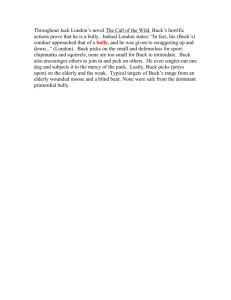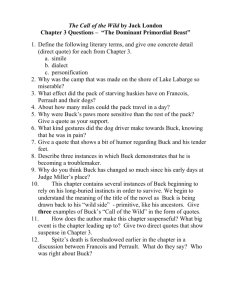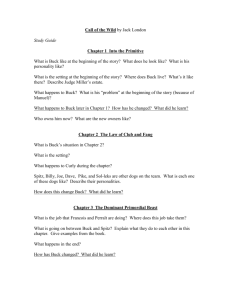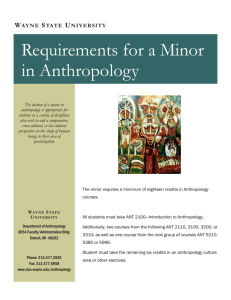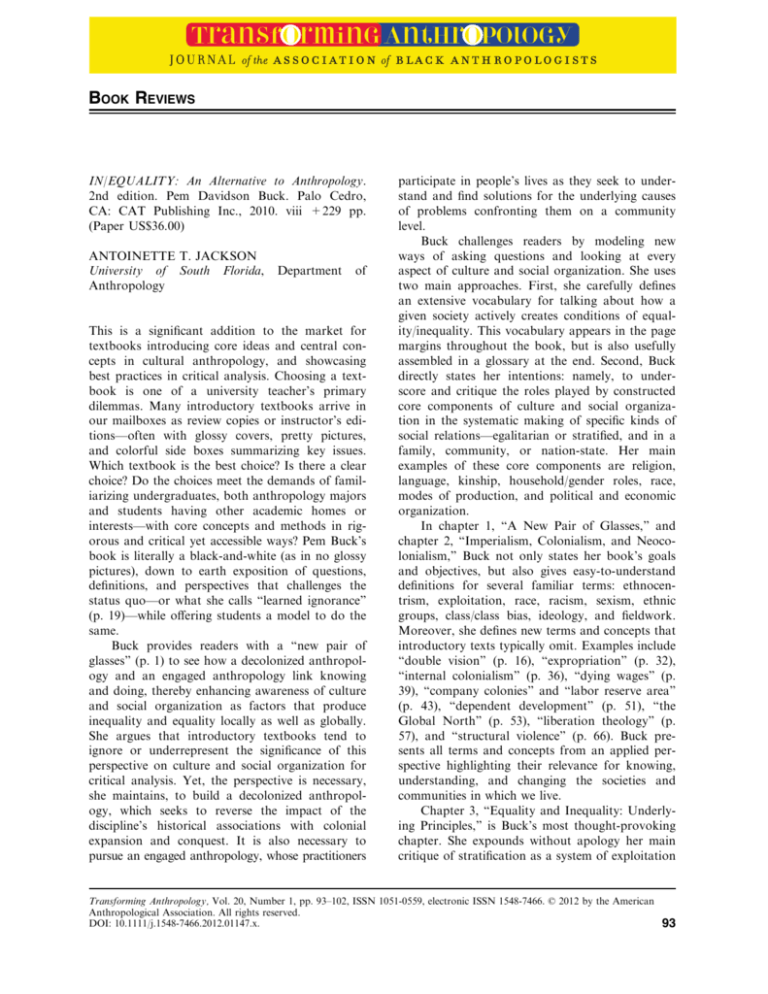
BOOK REVIEWS
IN/EQUALITY: An Alternative to Anthropology.
2nd edition. Pem Davidson Buck. Palo Cedro,
CA: CAT Publishing Inc., 2010. viii +229 pp.
(Paper US$36.00)
ANTOINETTE T. JACKSON
University of South Florida,
Anthropology
Department
of
This is a significant addition to the market for
textbooks introducing core ideas and central concepts in cultural anthropology, and showcasing
best practices in critical analysis. Choosing a textbook is one of a university teacher’s primary
dilemmas. Many introductory textbooks arrive in
our mailboxes as review copies or instructor’s editions—often with glossy covers, pretty pictures,
and colorful side boxes summarizing key issues.
Which textbook is the best choice? Is there a clear
choice? Do the choices meet the demands of familiarizing undergraduates, both anthropology majors
and students having other academic homes or
interests—with core concepts and methods in rigorous and critical yet accessible ways? Pem Buck’s
book is literally a black-and-white (as in no glossy
pictures), down to earth exposition of questions,
definitions, and perspectives that challenges the
status quo—or what she calls “learned ignorance”
(p. 19)—while offering students a model to do the
same.
Buck provides readers with a “new pair of
glasses” (p. 1) to see how a decolonized anthropology and an engaged anthropology link knowing
and doing, thereby enhancing awareness of culture
and social organization as factors that produce
inequality and equality locally as well as globally.
She argues that introductory textbooks tend to
ignore or underrepresent the significance of this
perspective on culture and social organization for
critical analysis. Yet, the perspective is necessary,
she maintains, to build a decolonized anthropology, which seeks to reverse the impact of the
discipline’s historical associations with colonial
expansion and conquest. It is also necessary to
pursue an engaged anthropology, whose practitioners
participate in people’s lives as they seek to understand and find solutions for the underlying causes
of problems confronting them on a community
level.
Buck challenges readers by modeling new
ways of asking questions and looking at every
aspect of culture and social organization. She uses
two main approaches. First, she carefully defines
an extensive vocabulary for talking about how a
given society actively creates conditions of equality/inequality. This vocabulary appears in the page
margins throughout the book, but is also usefully
assembled in a glossary at the end. Second, Buck
directly states her intentions: namely, to underscore and critique the roles played by constructed
core components of culture and social organization in the systematic making of specific kinds of
social relations—egalitarian or stratified, and in a
family, community, or nation-state. Her main
examples of these core components are religion,
language, kinship, household/gender roles, race,
modes of production, and political and economic
organization.
In chapter 1, “A New Pair of Glasses,” and
chapter 2, “Imperialism, Colonialism, and Neocolonialism,” Buck not only states her book’s goals
and objectives, but also gives easy-to-understand
definitions for several familiar terms: ethnocentrism, exploitation, race, racism, sexism, ethnic
groups, class/class bias, ideology, and fieldwork.
Moreover, she defines new terms and concepts that
introductory texts typically omit. Examples include
“double vision” (p. 16), “expropriation” (p. 32),
“internal colonialism” (p. 36), “dying wages” (p.
39), “company colonies” and “labor reserve area”
(p. 43), “dependent development” (p. 51), “the
Global North” (p. 53), “liberation theology” (p.
57), and “structural violence” (p. 66). Buck presents all terms and concepts from an applied perspective highlighting their relevance for knowing,
understanding, and changing the societies and
communities in which we live.
Chapter 3, “Equality and Inequality: Underlying Principles,” is Buck’s most thought-provoking
chapter. She expounds without apology her main
critique of stratification as a system of exploitation
Transforming Anthropology, Vol. 20, Number 1, pp. 93–102, ISSN 1051-0559, electronic ISSN 1548-7466. © 2012 by the American
Anthropological Association. All rights reserved.
DOI: 10.1111/j.1548-7466.2012.01147.x.
93
in state-based societies, while describing in detail
other options for organizing society. She boldly
states: “[S]tratified societies don’t represent progress for the majority of people in them in terms
of human well-being. They are much better … at
creating wealth for a few” (p. 72). Debunking the
equation of egalitarian societies with primitive
ways of life, Buck posits a framework for seeing
egalitarian societies and stratified societies as
learned states and ways of being, and analyzes systems, structures, and processes that make both
types of society possible by directing and regulating behavior. Throughout the chapter, she privileges egalitarian societies as valued forms of social
organization that make visible important ideas
about human behavior and equality/equitable
treatment. This characteristic of egalitarian societies, Buck argues, is often misrepresented or
ignored in textbooks emphasizing the significance
of stratified state-based societies for human progress. Here, she once again defines and applies
terms—for instance, “leveling device” (p. 83) and
“stratified redistribution” (p. 91)—that build readers’ vocabularies and help them understand the
construction of systems of equality and inequality
within a society.
In chapter 4, “Factoring in Gender,” and
chapter 5, “Factoring in Race, Caste, and Class,”
Buck uses a discussion of modes and means of
production to demonstrate how powerholders
manipulate social constructs to maintain and
advance systems of exploitation. In chapter 6,
“Maintaining Stratification,” Buck reviews powerholders’ systematic efforts to control society and
ensure that people accept, maintain, and reproduce
stratification. Finally, in chapter 7, “Globalization:
The Return of Empire,” is a call to arms. Buck
urge readers to remain vigilant, to apply anthropological knowledge consciously, to use new-found
glasses to see things differently, and recognize the
production of inequality in all of its forms, traditional or emergent, such as “globalized empire”
making (p. 193) in which wealth flows to the
Global North’s elites and upper middle classes.
Pem Buck believes that things can change and
her book helps readers to see what needs to be
changed, along with the implications of making
those changes on a community level in the context
of globalization. IN/EQUALITY: An Alternative
Anthropology is an alternative to conventional
textbooks in both content and presentation.
Whether teachers agree with Buck’s approach or
disagree with her audacious disruption of seemingly benign presentations of ever-growing lists of
94
TRANSFORMING ANTHROPOLOGY VOL. 20(1)
terms, concepts, and definitions in introductory
cultural anthropology courses, this book merits
careful consideration in conjunction with or
instead of more conventional textbooks. Their students will find it an instructive tool for developing
another way to look at and question what they
take for granted.
Race, Place and Globalization: Youth Culture in a
Changing World. Anoop Nayak. Oxford, UK, and
New York, NY: Berg Publishers (distributed by
New York University Press), 2003. ix +208 pp.
(Cloth US$109.00; Paper US$42.95)
JULIO CAMMAROTA
University of Arizona, Department of Mexican
American Studies
Paul Willis’s monumental ethnography of British
working-class youth, Learning to Labor (Willis
1977), helped to foster contemporary Critical
Youth Studies, a still rapidly growing field. The
seminal work evinces how young working-class
males actively produce, with a degree of creativity
and resistance, cultural forms and practices that
influence the development of their own subjectivities. This cultural production is not entirely autonomous, such that ideologies embedded in workingclass culture (writ large) find their way into youth
culture. Instead, Willis argues, youth draw specifically from the shop floor culture of manual
laborers, which made sense given limited future
possibilities—the likelihood that young men would
become manual laborers themselves. Unfortunately, many shop floor cultural values sustain
racism and sexism, requiring youth participants to
shape identities in direct opposition to immigrants
and women. However, the values are necessary to
produce subjectivities that include feeling superior
to non-manual laborers, which results, Willis
maintains, in high self-esteem or self-worth among
working-class youth.
In Race, Place and Globalization, Anoop
Nayak directly answers a puzzling question raised
by Willis’s study: with the disappearance of
manufacturing in de-industrialized societies, how
do working-class youth produce their masculine
identities without the shop floor’s influence?


